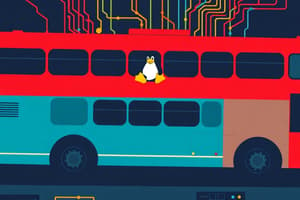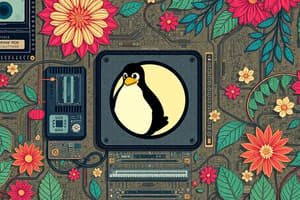Podcast
Questions and Answers
What is the primary function of operating system software?
What is the primary function of operating system software?
- To enhance the graphical user interface
- To provide security against malware
- To control the hardware of the computer (correct)
- To develop applications for user interaction
Which of the following is considered a hardware component of a computer?
Which of the following is considered a hardware component of a computer?
- Flash memory card readers (correct)
- Device drivers
- Operating system software
- User interfaces
Which statement accurately describes the purpose of a device driver?
Which statement accurately describes the purpose of a device driver?
- It controls the user interface of an operating system.
- It contains instructions for the OS to interact with hardware. (correct)
- It is a type of application designed for user interaction.
- It is a component that enhances the CPU performance.
Which of the following best describes applications in a computer system?
Which of the following best describes applications in a computer system?
What type of user interface can operating systems utilize to receive input?
What type of user interface can operating systems utilize to receive input?
What do odd minor numbers in Linux kernel versions indicate?
What do odd minor numbers in Linux kernel versions indicate?
Which of the following is NOT a characteristic of Open Source Software (OSS)?
Which of the following is NOT a characteristic of Open Source Software (OSS)?
What does the GNU Public License (GPL) require from users who modify the source code?
What does the GNU Public License (GPL) require from users who modify the source code?
Which component of a Linux kernel version number indicates the major revision?
Which component of a Linux kernel version number indicates the major revision?
How does Open Source Software (OSS) primarily increase its perceived value?
How does Open Source Software (OSS) primarily increase its perceived value?
What is a defining characteristic of the Artistic License in open source software?
What is a defining characteristic of the Artistic License in open source software?
Which of the following is NOT a type of closed source software license?
Which of the following is NOT a type of closed source software license?
What advantage does open source software (OSS) have over closed source software in terms of bug fixes?
What advantage does open source software (OSS) have over closed source software in terms of bug fixes?
What is a potential risk of relying on closed source software for businesses?
What is a potential risk of relying on closed source software for businesses?
Which of the following types of software is commonly available for Linux?
Which of the following types of software is commonly available for Linux?
What is a primary characteristic of the Linux operating system regarding user functionality?
What is a primary characteristic of the Linux operating system regarding user functionality?
Which of the following accurately describes the Linux kernel?
Which of the following accurately describes the Linux kernel?
What is one of the main functionalities provided by system services in an operating system?
What is one of the main functionalities provided by system services in an operating system?
Why is understanding Linux kernel version numbers important?
Why is understanding Linux kernel version numbers important?
In the context of Linux, multitasking refers to which of the following capabilities?
In the context of Linux, multitasking refers to which of the following capabilities?
The Linux operating system is primarily designed to run a limited number of applications on specific hardware components.
The Linux operating system is primarily designed to run a limited number of applications on specific hardware components.
The main purpose of an operating system is to serve as an interface between the user and the computer's hardware.
The main purpose of an operating system is to serve as an interface between the user and the computer's hardware.
The core component of Linux is known as the Linux core.
The core component of Linux is known as the Linux core.
All versions of the Linux kernel share the same appearance and functionality.
All versions of the Linux kernel share the same appearance and functionality.
Applications interact directly with the hardware without the intervention of the operating system.
Applications interact directly with the hardware without the intervention of the operating system.
A user interface can either be a command line prompt or a graphical user interface, allowing for user input.
A user interface can either be a command line prompt or a graphical user interface, allowing for user input.
Linux supports multitasking, which means it can manage thousands of tasks concurrently.
Linux supports multitasking, which means it can manage thousands of tasks concurrently.
A graphical user interface (GUI) allows users to interact with the operating system solely using commands.
A graphical user interface (GUI) allows users to interact with the operating system solely using commands.
Device drivers are unnecessary for operating systems to interact with hardware devices.
Device drivers are unnecessary for operating systems to interact with hardware devices.
The physical components of a computer are referred to as software.
The physical components of a computer are referred to as software.
A minor number in Linux kernel versions indicates the major revision to the kernel.
A minor number in Linux kernel versions indicates the major revision to the kernel.
An odd minor number in Linux kernel versions is associated with a production kernel.
An odd minor number in Linux kernel versions is associated with a production kernel.
Under the GNU Public License (GPL), users who have modified the source code are required to keep it confidential.
Under the GNU Public License (GPL), users who have modified the source code are required to keep it confidential.
Open Source Software (OSS) tends to be developed slowly due to lack of collaboration.
Open Source Software (OSS) tends to be developed slowly due to lack of collaboration.
According to the implications of OSS, software bugs are usually ignored and fixed only in major updates.
According to the implications of OSS, software bugs are usually ignored and fixed only in major updates.
The Artistic License allows the original author to make changes to the source code without rejection from the users.
The Artistic License allows the original author to make changes to the source code without rejection from the users.
Freeware is a form of closed source software that can be modified at any time by the user.
Freeware is a form of closed source software that can be modified at any time by the user.
Open source software allows for rapid identification and fixing of bugs due to its collaborative nature.
Open source software allows for rapid identification and fixing of bugs due to its collaborative nature.
A major drawback of closed source software is the dependency on the vendor for bug fixes, which can take an extended period.
A major drawback of closed source software is the dependency on the vendor for bug fixes, which can take an extended period.
Linux is ideal for individuals who prefer a rigid software environment with no customization options.
Linux is ideal for individuals who prefer a rigid software environment with no customization options.
Flashcards
Graphical User Interface (GUI)
Graphical User Interface (GUI)
The user interface that allows interaction with an operating system using a keyboard or mouse.
System Services
System Services
System services manage tasks like printing, program scheduling, and network access.
Multi-user
Multi-user
A Linux system can handle multiple users accessing it simultaneously.
Multitasking
Multitasking
Signup and view all the flashcards
Linux Kernel
Linux Kernel
Signup and view all the flashcards
What is an operating system?
What is an operating system?
Signup and view all the flashcards
What is operating system software?
What is operating system software?
Signup and view all the flashcards
What are applications (apps)?
What are applications (apps)?
Signup and view all the flashcards
What is a user interface?
What is a user interface?
Signup and view all the flashcards
What is a device driver?
What is a device driver?
Signup and view all the flashcards
Artistic License
Artistic License
Signup and view all the flashcards
Freeware
Freeware
Signup and view all the flashcards
Shareware
Shareware
Signup and view all the flashcards
Risk Reduction with Open Source
Risk Reduction with Open Source
Signup and view all the flashcards
Customization Advantage
Customization Advantage
Signup and view all the flashcards
What are the components of a Linux kernel version?
What are the components of a Linux kernel version?
Signup and view all the flashcards
What is Open Source Software?
What is Open Source Software?
Signup and view all the flashcards
What is source code?
What is source code?
Signup and view all the flashcards
What is the GNU Public License (GPL)?
What is the GNU Public License (GPL)?
Signup and view all the flashcards
What are the benefits of Open Source Software?
What are the benefits of Open Source Software?
Signup and view all the flashcards
Software
Software
Signup and view all the flashcards
Operating System (OS)
Operating System (OS)
Signup and view all the flashcards
Applications (Apps)
Applications (Apps)
Signup and view all the flashcards
Device Driver
Device Driver
Signup and view all the flashcards
GNU Public License (GPL)
GNU Public License (GPL)
Signup and view all the flashcards
Open Source Software (OSS)
Open Source Software (OSS)
Signup and view all the flashcards
Source code
Source code
Signup and view all the flashcards
Open Source License
Open Source License
Signup and view all the flashcards
Revision number
Revision number
Signup and view all the flashcards
What is a Graphical User Interface (GUI)?
What is a Graphical User Interface (GUI)?
Signup and view all the flashcards
What are system services?
What are system services?
Signup and view all the flashcards
What is the Linux Kernel?
What is the Linux Kernel?
Signup and view all the flashcards
What is the Linux kernel version format?
What is the Linux kernel version format?
Signup and view all the flashcards
What does it mean for Linux to support multitasking?
What does it mean for Linux to support multitasking?
Signup and view all the flashcards
What is Freeware?
What is Freeware?
Signup and view all the flashcards
What is Shareware?
What is Shareware?
Signup and view all the flashcards
What is "Artistic License" in OSS?
What is "Artistic License" in OSS?
Signup and view all the flashcards
What are the risks of using closed source software?
What are the risks of using closed source software?
Signup and view all the flashcards
How does Linux offer customization advantages?
How does Linux offer customization advantages?
Signup and view all the flashcards
Study Notes
Introduction to Linux
- Linux is an operating system (OS) used with a variety of applications and hardware.
- A computer has two fundamental components: hardware and software.
- Hardware includes the physical components inside a computer, such as the processor (CPU), physical memory (RAM), hard disk drives, CD and DVD drives, flash memory card readers (SD cards), sound cards, video cards, and circuit boards.
- Software is a set of instructions or programs that allow hardware components to manipulate data.
- Two types of programs are executed on a computer: applications and the operating system (OS).
- Applications are programs designed for a specific use and with which a user interacts.
- OS software contains components used to control the computer's hardware.
- Device drivers are software containing instructions the OS uses to control and interact with a specific device.
- The user interface (UI) is an application program that accepts user input, sends input to the OS for completion and returns results to the user.
- The UI can be a command line prompt or graphical user interface (GUI).
- A GUI is a component of an OS that allows the user to interact with the computer using the keyboard or mouse.
- System services are applications that handle system-related tasks, such as printing, scheduling programs, and gaining network access.
- Linux is used to run a variety of applications on a variety of hardware.
- Linux has multitasking capabilities, meaning it can manage thousands of tasks at once.
- Linux supports multi-user environments, allowing multiple users to access the system simultaneously.
- The core component of Linux is the kernel, which is written almost entirely in the C programming language.
- Software can be used to modify the appearance of Linux, but the kernel remains common to all versions.
- Understanding Linux kernel version numbers is important for selecting the appropriate version for user needs.
- Linux may be customized to provide services for a variety of companies in a variety of situations.
- Workstation services are services used on a local computer.
- Server services are services made available for other computers across a network.
Kernel Versions
- Linux kernel versions comprise of major, minor, and revision numbers.
- The major number indicates a major revision to the Linux kernel.
- The minor number indicates minor revisions and stability.
- Odd minor numbers denote developmental kernels, implying instability due to incomplete testing.
- Even minor numbers denote production kernels, indicating complete testing and stability.
- Kernel versions are often referred to as developmental or production, based on stability.
Licensing
- Linux is an Open Source Software (OSS). This means the software is distributed and licensed in a way that the source code is freely available.
- Source code refers to the list of instructions that programmers use to create programs, following rules set by programming languages.
- OSS encourages collaboration, leading to rapid development and quick bug fixes.
- Increased user needs dictate software feature evolution in OSS.
- OSS' perceived value increases because its worth is based on usefulness, rather than price.
Types of Open Source Licenses
- GNU Public License (GPL): This license was developed by the Free Software Foundation (FSF), stipulating that any software published under this license must be freely available.
- Users who modify the source code must also redistribute the modified code freely.
- Artistic license: Allows source code to be freely distributed, but changes must be at the discretion of the original author. The original author can reject changes.
Types of Closed Source Licenses
- Most closed source software is sold commercially.
- Software often bears the label of the manufacturer.
- Freeware is a type of closed source software that is given out free of charge.
- Source code isn't available.
- Shareware is a type of closed source software, initially free but paying after a certain time-period or to use certain features.
Linux Advantages
- Linux's open source nature allows for rapid adaptation to market changes. It reduces costs and time when changing software.
- Closed source software may experience support issues, vendor closures, or version retirements.
- The community-based development of OSS products allows the opportunity to maintain and change source code.
- A wealth of common software includes scientific and engineering software, emulators, web servers, web browsers, e-commerce suites, desktop productivity software, graphics manipulation software, database software, and security software.
- OSS products increase stability because the community collaborates on testing and fixing bugs.
- The open nature of the code leads to quick bug and security loophole identification and resolution.
- Linux OSs can be adapted and customized.
- A user can recompile the kernel for use on a specific task or situation.
- The ability to install only the required software packages, reduces the size and increases efficiency of the OS.
- Linux supports several programming languages, for creating customized and automated tasks, such as use of shell and PERL scripts.
- Linux is less expensive than other OSS offerings.
- There's no cost associated with acquiring software.
- A range of hardware platforms can run Linux.
- The largest cost of Linux is associated with hiring personnel to maintain the system.
UNIX
- UNIX evolved from a project called MULTICS.
- UNIX was the first true multitasking and multiuser OS.
- It was rewritten in the C programming language, making it portable to many different hardware platforms.
- AT&T sold UNIX source code.
- Various companies developed their versions (flavors) of UNIX, adhering to agreed-upon standards.
Common UNIX flavors
- Examples of popular UNIX today, include Oracle's Solaris, Hewlett-Packard's HP-UX, IBM's AIX UNIX, Apple's Macintosh OS X and iOS.
Common Linux Distributions
-
Debian Linux
-
Ubuntu Linux
-
Linux Mint
-
TurboLinux
-
Red Hat (includes Fedora)
-
SuSE
-
These distributions are collections of software containing the Linux kernel and libraries, combined with add-on software specific to a given use.
Summary of Linux Distribution
- Linux is a by-product of Open Source Software (OSS) development.
- Interest in embedded Linux OSs for smaller devices, like mobile devices, has increased since 2000.
- Based on its significant development, more application development from the OSS community is expected over the next decade.
- Linux is available in various distributions.
- All distributions share a common kernel but come with different OSS applications.
- Common uses of Linux include: Internet servers, file and print servers, application servers, cloud systems, supercomputers, scientific workstations, office/personal workstations, and mobile devices.
Studying That Suits You
Use AI to generate personalized quizzes and flashcards to suit your learning preferences.




